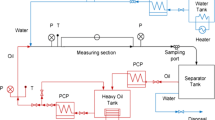Abstract
Flow of two immiscible fluids gives rise to variety of flow patterns, which influence transportation process. In this work, we present detailed analysis on the prediction of flow pattern maps and radial distribution of volume fraction, pressure and velocity of a pair of immiscible liquids through a horizontal pipeline by computational fluid dynamics (CFD) simulation using ANSYS FLUENT 6.3. Moderately viscous oil and water have been taken as the fluid pair for study. Volume of fluid (VOF) method has been employed to predict various flow patterns by assuming unsteady flow, immiscible liquid pair, constant liquid properties, and co-axial flow. From the grid independent study, we have selected 47 037 number of quadrilateral mesh elements for the entire geometry. Simulation successfully predicts almost all the flow patterns (viz., plug, slug, stratified wavy, stratified mixed and annular), except dispersion of oil in water and dispersion of water in oil. The simulated results are validated with experimental results of oil volume fraction and flow pattern map. Radial distribution of volume fraction, pressure and velocity profiles describe the nature of the stratified wavy, stratified mixed and annular flow pattern. These profiles help to developing the phenomenological correlations of interfacial characteristics in two-phase flow.
Similar content being viewed by others
References
AL-WAHAIBI T., ANGELI P. Experimental study on interfacial waves in stratified horizontal oil-water flow[J]. International Journal of Multiphase Flow, 2011, 37(8): 930–940.
CHAKRABARTI D. P., DAS G. and DAS P. K. Identification of stratified liquid—liquid flow through horizontal pipes by a non-intrusive optical probe[J]. Chemical Engineering Science, 2007, 62(7): 1861–1876.
ANGELI P., HEWITT G. F. Flow structure in horizontal oil-water flow[J]. International Journal of Multiphase Flow, 2000, 26(7): 1117–1140.
RUSSELL T. W. F., HODGSON G. W. GOVIER G. W. Horizontal pipeline flow of mixtures of oil and water[J]. Canadian Journal of Chemical Engineering, 1959, 37(1): 9–17.
RODRIGUEZ O. M. H., OLIEMANS R. V. A. Experimental study on oil-water flow in horizontal and slightly inclined pipes[J]. International Journal of Multiphase Flow, 2006, 32(3): 323–343.
TRALLERO J. L., SARICA C. and BRILL J. P. A study of oil-water flow patterns in horizontal pipes[J]. Social Science Electronic Publishing, 1997, 12(3): 165–172.
BRAUNER N. The prediction of dispersed flows boundaries in liquid-liquid and gas-liquid systems[J]. International Journal of Multiphase Flow, 2001, 27(5): 885–910.
BRAUNER N., MARON D. M. Flow pattern transitions in two-phase liquid-liquid flow in horizontal tubes[J]. International Journal of Multiphase Flow, 1992, 18(1): 123–140.
SOLEIMANI A., HANRATTY T. J. Critical liquid flows for the transition from the pseudo-slug and stratified patterns to slug flow[J]. International Journal of Multiphase Flow, 2003, 29(1): 51–67.
KO T., CHOI H. G. and BAI R. et al. Finite element method simulation of turbulent wavy core-annular flows using a turbulence model method[J]. International Journal of Multiphase Flow, 2002, 28(7): 1205–1222.
GHOSH S., DAS G. and DAS P. K. Simulation of core annular downflow through CFD—A comprehensive study[J]. Chemical Engineering and Processing Process Intensification, 2010, 49(11): 1222–1228.
GHOSH S., DAS G. and DAS P. K. Simulation of core annular in return bends—A comprehensive CFD study[J]. Chemical Engineering Research and Design, 2011, 89(11): 2244–2253.
KAUSHIK V. V. R., GHOSH S. and DAS G. et al. CFD simulation of core annular flow through sudden contraction and expansion[J]. Journal of Petroleum Science and Engineering, 2012, 86–87: 153–164.
HERZOG N., SCHREIBER M. and EGBERS C. A comparative study of different CFD—codes for numerical simulation of gas—solid fluidized bed hydrodynamics[J]. Computers and Chemical Engineering, 2012, 39(10): 41–46.
BANNARI R., KERDOUSS F. and SELMA B. et al. Three-dimensional mathematical modeling of dispersed two-phase flow using class methods of population balance in bubble columns[J]. Computers and Chemical Engineering, 2008, 32(12): 3224–3237.
AL-YAARI M. A., ABU-SHARKH B. F. CFD prediction of stratified oil-water flow in a horizontal pipe[J]. Asian Transactions on Engineering, 2011, 1(5): 68–75.
GHORAI S., NIGAM K. D. P. CFD modeling of flow profiles and interfacial phenomena in two-phase flow in pipes[J]. Chemical Engineering and Processing, 2006, 45(1): 55–65.
SIDI-ALI K., GATIGNOL R. Interfacial friction factor determination using CFD simulations in a horizontal stratified two-phase flow[J]. Chemical Engineering Science, 2010, 65(18): 5160–5169.
DASARI A., DESAMALA A. B. and DASMAHAPATRA A. K. et al. Experimental studies and PNN prediction on flow pattern of viscous oil-water flow through circular horizontal pipe[J]. Industrial and Engineering Chemistry Research, 2013, 52: 7975–7985.
Fluent Inc. Fluent 6.3 User’s Guide[M]. Lebanon, USA: Fluent Inc., 2005.
BRACKBILL J. U., KOTHE D. B. and ZEMACH C. A continuum method for modeling surface tension[J]. Journal of Computational Physics, 1992, 100(2): 335–354.
DESAMALA A. B., DASARI A. and VINAYAK V. et al. CFD simulation and validation of flow pattern transition boundaries during moderately viscous oil-water two-phase flow through horizontal pipeline[J]. World Academy of Science, Engineering and Technology, International Journal of Chemical, Materials Science and Engineering, 2013, 7(1): 1–6.
PATANKAR S. V. Numerical heat transfer and flud flow[M]. Washington DC, USA: Hemisphere, 1980.
ISSA R. I. Solution of the implicitly discretised fluid flow equations by operator-splitting[J]. Journal of Computational Physics, 1986, 62(1): 40–65.
Author information
Authors and Affiliations
Corresponding author
Additional information
Biography: Anand B. DESAMALA (1985-), Male, Ph. D.
Rights and permissions
About this article
Cite this article
Desamala, A.B., Vijayan, V., Dasari, A. et al. Prediction of oil-water flow patterns, radial distribution of volume fraction, pressure and velocity during separated flows in horizontal pipe. J Hydrodyn 28, 658–668 (2016). https://doi.org/10.1016/S1001-6058(16)60670-4
Received:
Revised:
Published:
Issue Date:
DOI: https://doi.org/10.1016/S1001-6058(16)60670-4




